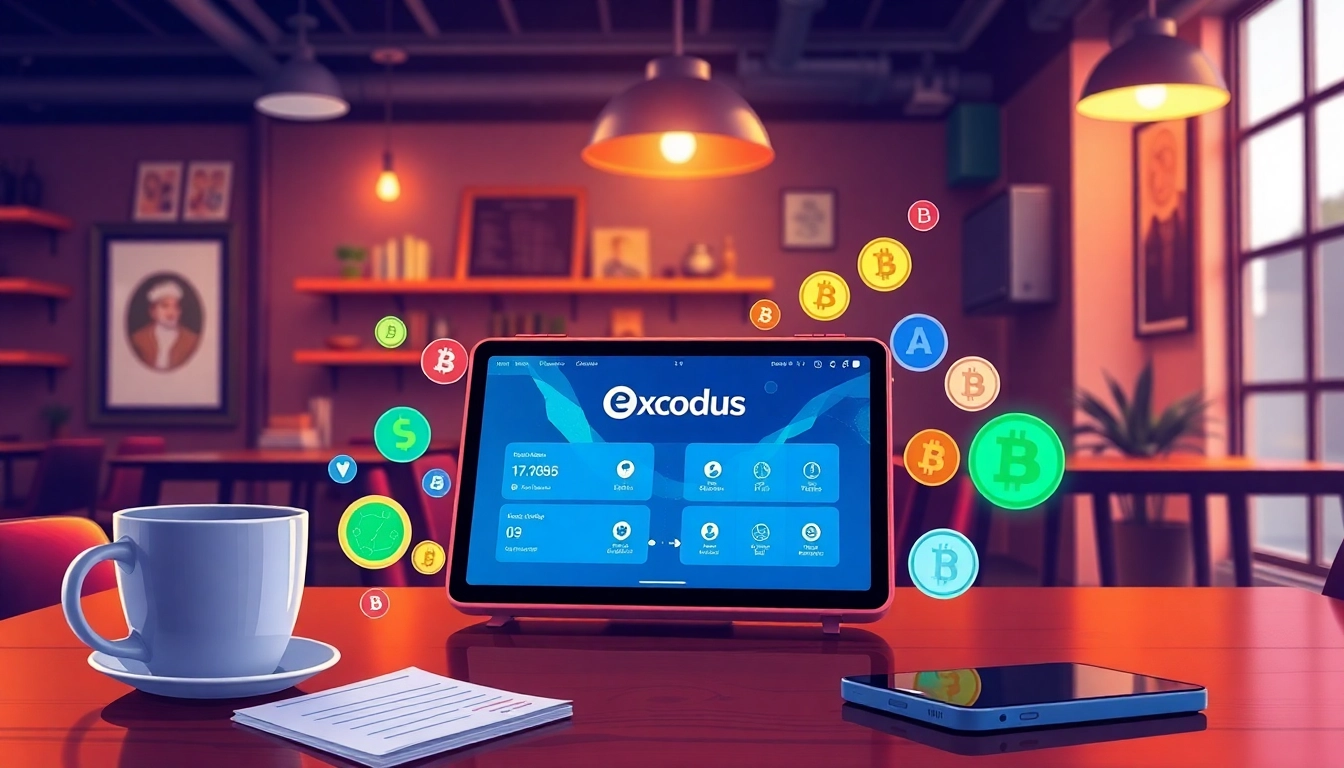1. Introduction to Exodus Wallet
The world of cryptocurrency is rapidly evolving, and with it, the tools required to manage digital assets must also advance. Whether you’re a seasoned trader or a newcomer to the crypto space, having a reliable wallet is crucial. Enter the exodus wallet, a multi-faceted solution that combines usability and security to cater to a wide array of cryptocurrency enthusiasts.
1.1 What is Exodus Wallet?
Exodus Wallet is a non-custodial software wallet designed to provide users with a seamless experience for managing various cryptocurrencies. Unlike custodial wallets, which store private keys on behalf of the user, Exodus allows individuals to maintain full control over their funds. Its significant advantage lies in its user-friendly interface, making it accessible even for those who are not technologically inclined. With support for hundreds of cryptocurrencies, Exodus operates as a desktop and mobile app, providing a versatile solution for crypto management.
1.2 Key Features of Exodus Wallet
Exodus Wallet is packed with features that make it appealing to both beginners and experienced users alike. Key offerings include:
- Multi-Currency Support: Users can store, send, receive, and swap a wide array of cryptocurrencies, including Bitcoin, Ethereum, and many altcoins.
- Integrated Exchange: The wallet features an in-built exchange that enables users to swap cryptocurrencies without leaving the app.
- User-Friendly Interface: Designed with simplicity in mind, Exodus presents a clean and intuitive interface for easy navigation.
- Portfolio Tracking: The wallet provides insights into asset distribution and value changes over time, helping users keep track of their investments more efficiently.
- Security Features: Users can protect their wallets with a password and use recovery phrases for retrieving access in case of lost access.
1.3 Why Choose the Exodus Wallet?
Choosing the right cryptocurrency wallet is paramount for securing assets and ensuring a smooth transactional experience. Here are several reasons why Exodus Wallet stands out:
- Control and Privacy: As a non-custodial wallet, Exodus allows users complete control over their private keys and funds, ensuring higher security and privacy.
- Ease of Use: Its friendly design is perfect for beginners while offering enough depth for experienced users.
- Ongoing Development: Exodus continually updates its software to implement new features and security measures, adapting to the rapidly changing market conditions.
- Community Engagement: The Exodus team actively engages with users, often seeking feedback to improve the wallet further.
2. Setting Up Your Exodus Wallet
2.1 Downloading Exodus Wallet
Getting started with Exodus Wallet is a simple process. Begin by visiting the official exodus wallet website where you can download the wallet for desktop or mobile. It is available for Windows, macOS, Linux, Android, and iOS. Make sure to download from the official site to avoid counterfeit versions, as security is paramount.
2.2 Creating Your Wallet Account
Once downloaded, launching the application will take you through the setup process. Follow these steps:
- Open the application, and you will be presented with an option to create a new wallet.
- Upon selection, you will be prompted to create a backup phrase. This phrase is critical for recovering your wallet, so ensure it is stored securely offline.
- After confirming your backup phrase, your wallet will be created, and you can start to customize it according to your preferences.
2.3 Setting Up Security Features
Security is a top priority when managing cryptocurrencies. Exodus Wallet provides several options to protect your assets:
- Strong Password: Set a strong password to secure your wallet from unauthorized access.
- Backup Phrase: Utilize the wallet’s 12-word recovery phrase feature to back up your wallet. Store this phrase securely, as it is the key to accessing your funds if you forget your password or lose access to the device.
- Two-Factor Authentication (2FA): Although Exodus currently does not support 2FA, users are encouraged to enable it on email and accounts associated with the wallet for added protection.
3. Using the Exodus Wallet Effectively
3.1 Sending and Receiving Cryptocurrencies
To send and receive cryptocurrencies through Exodus Wallet, users follow these simple steps:
- Receiving Funds: Navigate to the “Wallet” tab, select your desired cryptocurrency, and click on “Receive.” You will see a QR code and an address to share with the sender.
- Sending Funds: When sending cryptocurrency, select the asset type, enter the recipient’s address, specify the amount, and then confirm the transaction. Users are notified once the transaction is completed.
3.2 Trading Cryptos on the Exodus Wallet
One of the standout features of Exodus Wallet is its integrated trading option. Users can easily swap various cryptocurrencies right within the app:
- Open the “Exchange” tab within the wallet.
- Choose the coins you want to exchange and specify the amounts.
- Review the rates and confirm the exchange. The wallet will execute the swap, and the new assets will be reflected in your wallet.
This feature offers convenience for users who want to trade without accessing external exchanges, minimizing fees and facilitating quicker transactions.
3.3 Managing Multiple Assets in Exodus Wallet
Exodus Wallet supports a large variety of cryptocurrencies, allowing users to manage multiple assets seamlessly:
- Portfolio Overview: The wallet provides a visual representation showing the value of your assets, facilitating easy tracking of your investments.
- Asset Management: Users can add or remove cryptocurrencies by clicking on “Add More Assets” in the wallet’s settings.
- Transaction History: To monitor specific transactions, users can easily access their transaction history for each asset, providing transparency and control.
4. Understanding Fees and Limits
4.1 Overview of Exodus Wallet Fees
Understanding fees is vital when using any wallet. Exodus does not charge a fee for transactions within the wallet itself; however, there are some costs associated with crypto exchanges and network fees:
- Network Fees: These are determined by the respective blockchain network and can fluctuate based on network congestion.
- Spread Fees: Exodus may incorporate a spread fee when swapping coins. This spread can vary depending on the market volatility and trading partners.
4.2 Transaction Limits and What They Mean
When engaging in transactions on Exodus, users should note there are limits that vary by asset and transaction method:
- Minimum and Maximum Transaction Amounts: Each cryptocurrency has its own minimum and maximum limits for transactions, which can be checked in the wallet interface.
- Daily Limits: For specific services, there may be daily limits to how much can be exchanged or purchased within the app, aimed at safeguarding user accounts.
4.3 Strategies to Minimize Costs
To reduce costs when using Exodus Wallet, users can implement these strategies:
- Optimize Timing: Monitor network fees and try transferring during lower congestion times to minimize costs.
- Use the Built-in Exchange Wisely: Compare exchange rates in Exodus with other platforms to ensure you’re getting the best deal while exchanging currencies.
- Consolidate Transactions: Where possible, batching transactions can help in avoiding repeat fees associated with multiple smaller transactions.
5. Exodus Wallet Security Tips
5.1 Ensuring Your Wallet is Secure
Securing your Exodus Wallet involves both in-app measures and external practices. Here are several key practices:
- Device Security: Ensure your computer or mobile device has updated antivirus software and is running the latest operating system.
- Secure Your Backup: Store your backup phrase in a safe location that is resistant to theft and damage.
5.2 The Importance of Backup
A backup is critical. If you lose access to your wallet, your funds could be irretrievable. To reinforce this, follow these practices:
- Create Multiple Backups: Store copies of your recovery phrase in different secure locations.
- Test Recovery: Regularly test the recovery process to ensure your backup phrase works seamlessly.
5.3 Common Security Pitfalls to Avoid
Even with strong security measures, mistakes can happen. Common pitfalls to avoid include:
- Phishing Scams: Be cautious of unsolicited emails or messages asking for your private keys or personal information.
- Sharing Sensitive Information: Never share your backup phrase or login information with anyone, even if the request appears to be from a friend.
- Neglecting Software Updates: Always keep your wallet updated to benefit from the latest security features and fixes.


